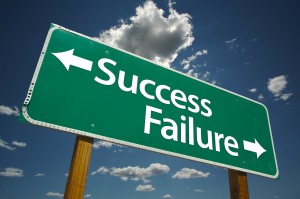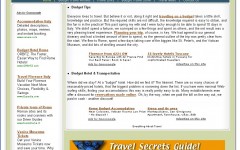If you were to do a search for the keyword “make money online”, you would get back thousands of websites that would teach you to build start-from-nothing businesses, such as long-tail AdSense websites, strategies to generate revenue with affiliate marketing and blueprints to make money with Facebook or Twitter. Many people in online business get started doing these types of things, but they rarely ever generate significant amounts of wealth.
Level-One Businesses
I call these level-one business models. They don’t take much to get started because you’re making use of other company’s resources and platforms. There are a lot of people using these business models, some successfully and some not and you generally don’t have a community or subscriber base built around your business. You might make some amount of money with these types of business models, but they very rarely scale up to four or five figures in monthly revenue. Some notable examples of successful level-one businesses include Pat Flynn’s Security Guard Training website and Spencer Haws’ Best Survival Knife Guide website.
Why Not to Build a Level-One Business
There are three major issues with level-one business models. First, there are no barriers to entry. It costs almost nothing to build a website that you hope will get search traffic from Google that will turn into ad dollars. Anyone that can read a few guides online, put some time in and do very basic website development work can build a network of niche AdSense websites. Because there are no barriers to entry, there’s a ton of competition. Not only are you competing with other would-be entrepreneurs, you’re also competing with major, established brands for search traffic. You’re just one more website in Google’s massive search index and aren’t likely to generate a significant income without a substantial amount of content development and marketing work.
Second, you’re wholly dependent upon someone else’s ecosystem when you’re building a level-one business. When Facebook decided it was going to charge publishers to reach the audience of their Facebook fan pages, many entrepreneurs’ business models stopped working overnight. When Google added the Panda and Penguin algorithms to their ranking system, many people stopped receiving any meaningful amount of search traffic over night. There are thousands of occurrences where an affiliate program changed their rules or payout structure and people that were making large amounts of money lost their income stream overnight. When your business is totally reliant on another company whose interests aren’t necessarily aligned with yours, you’re asking for trouble.
Finally, you generally don’t have a customer list or a user community with level-one businesses. People will come to your website from Google, read your article and hopefully click through to a contextual ad-banner or an affiliate link to Amazon. You never collect the ability to contact them again in the future by way of email or have an active community surrounding your business. Because you can’t independently contact your audience outside of whatever traffic method you’ve latched onto, you’re even more dependent upon Facebook, Twitter, Pinterest or Google to keep your business going. Companies that have customer lists and user communities are far more sustainable than those that don’t, because they can always rely on their existing customer list for revenue, even if search engines and social media sites stop sending them web traffic.
The Anatomy of a Level-Two Business
If the gold miners of the 19th century were entrepreneurs with level-one business models, the people that sold canvas tents, blue jeans, shovels and mining picks to miners had level-two business models. Equipment suppliers had a steady customer base of miners and made use of skills to do things that only a handful of people could do. Anyone could become a gold miner, but selling mining and camping equipment required manufacturing, importation, marketing and sales skills. These people generally did far better than the boom-or-bust gold miners of the 19th century. Their businesses were more stable, relatively predictable and had real barriers to entry.
Level-two businesses make use of personal skills and abilities, have some form of barrier to entry, don’t rely on a single platform for traffic and revenue and result in the building of a community of customer list. Examples of level-two businesses include e-commerce stores, membership websites and software-as-a-service (SaaS) businesses.
How to Build a Level-Two Business
 If you want to graduate beyond a level-one business, you need to start looking at more complex business models that not everyone can do. Take inventory of your unique skills and abilities and try to identify businesses that would make use of your personal strengths. If you have audio or video production skills, you might offer a service that does Podcast or video production. If you have significant knowledge about a certain trade, skill or hobby, you might offer consulting services, a paid email newsletter or a membership website. If you can write software and have a good mind for business processes, you might built a SaaS business. You don’t necessarily have to be passionate about the level-two business you’re building, but you should have some skills that will contribute to the growth of your business. The key is to find a business model that you can do that has meaningful barriers to entry in the form of required skills or resources.
If you want to graduate beyond a level-one business, you need to start looking at more complex business models that not everyone can do. Take inventory of your unique skills and abilities and try to identify businesses that would make use of your personal strengths. If you have audio or video production skills, you might offer a service that does Podcast or video production. If you have significant knowledge about a certain trade, skill or hobby, you might offer consulting services, a paid email newsletter or a membership website. If you can write software and have a good mind for business processes, you might built a SaaS business. You don’t necessarily have to be passionate about the level-two business you’re building, but you should have some skills that will contribute to the growth of your business. The key is to find a business model that you can do that has meaningful barriers to entry in the form of required skills or resources.
Your level-two business should have a steady and reliable means of contacting prospective customers independent of Apple, Amazon, Facebook, Google, Microsoft, Pinterest or Twitter. This might mean you’re cold calling other small businesses, using direct mail, doing guest blogging, engaging in email marketing or offering to be a guest on other people’s podcasts. Alternatively, you can make use of the big-traffic sending platforms if you have multiple traffic sources. If you’re getting customers from Bing, Google, your iPhone/iPad app, Facebook, Twitter and Amazon, you’re a lot more diversified than if you’re just getting sales through Amazon or traffic through Google. You should have your marketing strategy figured out before you start building your product or service, because the best product or service in the world won’t do anyone any good if they don’t know about it.
Finally, your level-two business should result in you building a database of subscribers/customers (preferably in the form of email addresses) that you can contact in the future. Ideally, there will be some sort of community that exists surrounding your business as well. If you have a list of subscribers or customers, you have the ability to maintain a relationship with them and sell to them again in the future, regardless of your standing with search engines and social media platforms.
My Transition from a Level-One Business to Multiple Level-Two Businesses
 When I started in online business in 2007, I created a few personal finance websites. They made about five thousand dollars per month at their peak in ad-revenue. They did okay. Unfortunately, there were hundreds of other personal finance bloggers doing the same thing. I probably wasn’t going to be the guy that stood above the rest of the crowd and to be honest, they weren’t that fun to operate. Pounding out a few blog posts per day was certainly not how I wanted to spend the rest of my life. I hired a couple of writers and set my personal finance websites on auto-pilot. They continued to do okay until 2011 when Google started introducing significant changes into its search algorithm and have dwindled since then.
When I started in online business in 2007, I created a few personal finance websites. They made about five thousand dollars per month at their peak in ad-revenue. They did okay. Unfortunately, there were hundreds of other personal finance bloggers doing the same thing. I probably wasn’t going to be the guy that stood above the rest of the crowd and to be honest, they weren’t that fun to operate. Pounding out a few blog posts per day was certainly not how I wanted to spend the rest of my life. I hired a couple of writers and set my personal finance websites on auto-pilot. They continued to do okay until 2011 when Google started introducing significant changes into its search algorithm and have dwindled since then.
Fortunately, along the way, I had the insight to start building business with level-two characteristics. I had a few investing news websites, like American Banking and Market News, which got traffic from places like Stock Twits, Google Finance, Market Watch and MSN Money. Eventually, I started collecting email addresses for my newsletter business that became ARN Daily and ARN Daily Premium.
In late 2012, I built another business called Lightning Releases that offers digital press release distribution to non-profits, small businesses and authors. That business does not rely on any major platform for customer acquisition, makes use of my unique skills and abilities and has a growing list of customers and prospective customers.
This summer, I started yet-another online business called GoGo Photo Contest, which allows humane societies and animal shelters to run photo contest fundraiser. All of our customers for that business come through email marketing and word of mouth. That business makes use of my unique skills and abilities and has a growing list of customers that could be leveraged in the future when we build out another web-based fundraising platform.
Final Thoughts
If you’re going to build a business that’s going to be successful over the long term, build something that not anyone with some free time can build. Build a business that has some barriers to entry and makes use of your unique skills and abilities. Don’t rely solely on traffic from Google or Facebook. Build a customer/subscribe list that you can leverage in the future. Build a level-two business.


